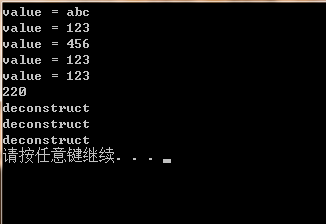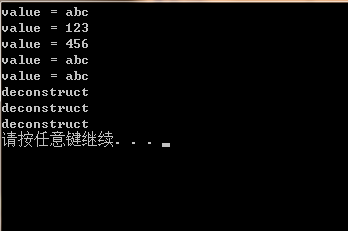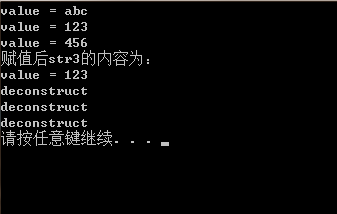事实上,重载运算符返回void、返回对象本身、返回对象引用都是可以的,并不是说一定要返回一个引用,只不过在不同的情况下需要不同的返回值。
那么什么情况下要返回对象的引用呢?
原因有两个:
- 允许进行连续赋值
- 防止返回对象(返回对象也可以进行连续赋值(常规的情况,如a = b = c,而不是(a = b) = c))的时候调用拷贝构造函数和析构函数导致不必要的开销,降低赋值运算符的效率。
对于第二点原因:如果用”值传递“的方式,虽然功能仍然正确,但由于return语句要把*this拷贝到保存返回值的外部存储单元之中,增加了不必要的开销,会降低赋值函数的效率。
场景:
需要返回对象引用或者返回对象(效率没有返回引用高),需要实现连续赋值,使重载的运算符更符合C++本身的运算符语意,如连续赋值 = += -= *= 、=,<<输出流
关于赋值 =,我们知道赋值=有连续等于的特性
int x,y,z;
x=y=z=15;
同样有趣的是,赋值采用的是右结合律,所以上述连锁赋值被解析为:
这里15先被赋值给z,然后其结果(更新后的z)再被赋值给y,然后其结果(更新后的y)再被赋值给x。

为了实现”连锁赋值“,赋值操作符号返回一个reference(引用)指向操作符号的左侧实参(而事实上重载运算符的左侧实参就是调用对象本身,比如= += -=等),这是为classes实现赋值操作符时应该遵循的协议:这个协议不仅仅适用于以上的标准赋值形式,也适用于所有赋值运算。
class Widght{
public:
.....
Widget& operator=(cosnt Widget& rhs)
{
...
return* this;
}
Widget& operator+=(cosnt Widget& rhs)
{
...
return* this;
}
Widget& operator-=(cosnt Widget& rhs)
{
...
return* this;
}
Widget& operator*=(cosnt Widget& rhs)
{
...
return* this;
}
Widget& operator/=(cosnt Widget& rhs)
{
...
return* this;
}
...
};
注意,这只是个协议,并无强制性,如果不遵循它,代码一样可以通过编译,然而这份协议被所有内置类型和标准程序库提供的类型入string,vector,complex,std::trl::shared_ptr或者即将提供的类型共同遵守。因此除非你有一个标新立异的好理由,不然还是随众吧。
下面看一个赋值运算符重载的例子:(连续赋值,常规的情况(a = b = c))
1、首先是返回对象的情况:
#include <iostream>
using namespace std;
class String
{
private:
char *str;
int len;
public:
String(const char* s);//构造函数声明
String operator=(const String& another);//运算符重载,此时返回的是对象
void show()
{
cout << "value = " << str << endl;
}
/*copy construct*/
String(const String& other)
{
len = other.len;
str = new char[len + 1];
strcpy(str, other.str);
cout << "copy construct" << endl;
}
~String()
{
delete[] str;
cout << "deconstruct" << endl;
}
};
String::String(const char* s)//构造函数定义
{
len = strlen(s);
str = new char[len + 1];
strcpy(str, s);
}
String String::operator=(const String &other)//运算符重载
{
if (this == &other)
return *this;
// return;
delete[] str;
len = other.len;
str = new char[len + 1];
strcpy(str, other.str);
return *this;
// return;
}
int main()
{
String str1("abc");
String str2("123");
String str3("456");
str1.show();
str2.show();
str3.show();
str3 = str1 = str2;//str3.operator=(str1.operator=(str2))
str3.show();
str1.show();
return 0;
}
运行结果:

2、下面是返回引用的情况(String& operator = (const String& str)),直接贴运行结果:

当运算符重载返回的是对象时,会在连续赋值运算过程的返回途中,调用两次拷贝构造函数和析构函数(因为return的是个新的对象)
如果采用String& operator = (const String& str)这样就不会有多余的调用(因为这里直接return一个已经存在的对象的引用)
上面的例子也说明一点:析构函数的调用是在变量作用域结束的时候(以及程序运行结束的时候)
如果采用return对象,那么第二次赋值运算调用的情况就是:
将一个新的String对象(returnStringObj)传递到operator = (const String& str)的参数中去 相当于
const String&str = returnStringObj;
如果采用return对象引用,那么第二次赋值运算的情况就是:
将一个已经存在的String对象的引用((其实就是str1))传递给operator = (const String& str)的参数中去
const String&str = returnReference; //(String& returnReference = str1;)
+=等运算符也是同样的考虑,比如
int main()
{
String str1("abc");
String str2("123");
String str3("456");
str1.show();
str2.show();
str3.show();
str3 = str1 = str2;//str3.operator=(str1.operator=(str2))
str3.show();
str1.show();
int num = 10;
num += (num += 100);
cout << num << endl;
return 0;
}

如果使用+=或其它上面举出的运算符进行连续操作时,,则这些运算符的返回值一定要是一个对象或者引用才行,不然就会出现错误(参数类型不符合)。什么意思呢,下面举个例子。
现在让运算符重载返回的类型为空,单个赋值,不使用连续赋值:
#include <iostream>
using namespace std;
class String
{
private:
char *str;
int len;
public:
String(const char* s);//构造函数声明
void operator=(const String& another);//运算符重载,此时返回为空
void show()
{
cout << "value = " << str << endl;
}
/*copy construct*/
String(const String& other)
{
len = other.len;
str = new char[len + 1];
strcpy(str, other.str);
cout << "copy construct" << endl;
}
~String()
{
delete[] str;
cout << "deconstruct" << endl;
}
};
String::String(const char* s)
{
len = strlen(s);
str = new char[len + 1];
strcpy(str, s);
}
void String::operator=(const String &other)
{
if (this == &other)
// return *this;
return;
delete[] str;
len = other.len;
str = new char[len + 1];
strcpy(str, other.str);
// return *this;
return;
}
int main()
{
String str1("abc");
String str2("123");
String str3("456");
str1.show();
str2.show();
str3.show();
str3 = str1;//这样OK
str3.show();
str1.show();
return 0;
}
运行结果:

但当把主函数中str1,str2,str3改为连续赋值时:
int main()
{
String str1("abc");
String str2("123");
String str3("456");
str1.show();
str2.show();
str3.show();
str3 = str1=str2;//这样不OK
str3.show();
str1.show();
return 0;
}
出错:IntelliSense:没有与这些操作数匹配的“=”运算符
操作数类型为:String=void
所以,当确定不使用连续赋值时,直接返回void也是可以的。要明白一点:
运算符左侧的对象就是操作对象,比如
ObjectA = ObjectB 等同于ObjectA.operator=(ObjectB)
ObjectA+=ObjectB 等同于ObjectA.operator+(ObjectB)
最后要说明一点:并非必须返回引用,返回引用的好处既可以避免拷贝构造函数和析构函数的调用,又可以保证= +=等运算符的原始语义清晰。
啥叫原始语义清晰呢?
如
(str3 = str1) = str2;
我们的意识里,就是先执行括号内容,即str1赋值给str3,然后str2再赋值给str3,最后str3输出的内容是str2的。
即如果运算符重载返回的是对象引用时,
//返回的是对象引用的情况
#include <iostream>
using namespace std;
class String
{
private:
char *str;
int len;
public:
String(const char* s);//构造函数声明
String& operator=(const String& another);//运算符重载,此时返回为引用
void show()
{
cout << "value = " << str << endl;
}
/*copy construct*/
String(const String& other)
{
len = other.len;
str = new char[len + 1];
strcpy(str, other.str);
cout << "copy construct" << endl;
}
~String()
{
delete[] str;
cout << "deconstruct" << endl;
}
};
String::String(const char* s)
{
len = strlen(s);
str = new char[len + 1];
strcpy(str, s);
}
String& String::operator=(const String &other)
{
if (this == &other)
return *this;
// return;
delete[] str;
len = other.len;
str = new char[len + 1];
strcpy(str, other.str);
return *this;
// return;
}
int main()
{
String str1("abc");
String str2("123");
String str3("456");
str1.show();
str2.show();
str3.show();
(str3 = str1) = str2;
cout << "str3的内容为:" << endl;
str3.show();
return 0;
}
运行结果:

str3得到了str2的内容,与我们认识的‘=’运算符逻辑相符。
而如果运算符重载返回的是对象时,
//这是返回类型为对象的情况
#include <iostream>
using namespace std;
class String
{
private:
char *str;
int len;
public:
String(const char* s);//构造函数声明
String operator=(const String& another);//运算符重载,此时返回为空
void show()
{
cout << "value = " << str << endl;
}
/*copy construct*/
String(const String& other)
{
len = other.len;
str = new char[len + 1];
strcpy(str, other.str);
cout << "copy construct" << endl;
}
~String()
{
delete[] str;
cout << "deconstruct" << endl;
}
};
String::String(const char* s)
{
len = strlen(s);
str = new char[len + 1];
strcpy(str, s);
}
String String::operator=(const String &other)
{
if (this == &other)
return *this;
// return;
delete[] str;
len = other.len;
str = new char[len + 1];
strcpy(str, other.str);
return *this;
// return;
}
int main()
{
String str1("abc");
String str2("123");
String str3("456");
str1.show();
str2.show();
str3.show();
(str3 = str1) = str2;
cout << "赋值后str3的内容为:" << endl;
str3.show();
return 0;
}
运行结果:

str3只得到了str1的内容,并没有得到str2的内容,这是因为执行(str3=str1)后,因为返回的是对象(一个临时对象,str3的一个拷贝),不是引用,所以此时str3不在后面的‘=str2’的操作中,而是str2对一个临时对象赋值,所以str3的内容保持不变(等于str1)。
总结
所以,对此类运算符重载时,还是老老实实的返回引用,不要瞎搞,做个乖孩子